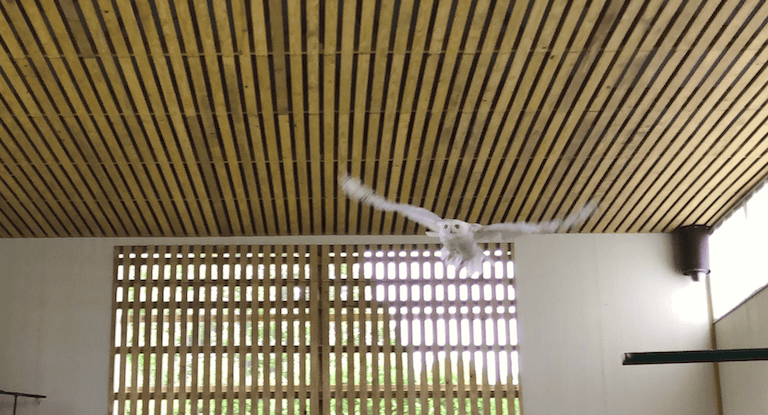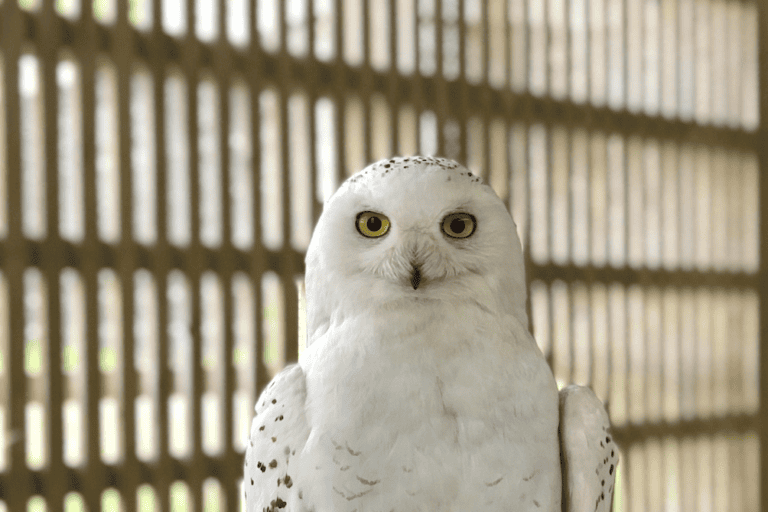- A snowy owl injured on its Massachusetts wintering grounds was brought to Tufts Wildlife Clinic this spring.
- In nature, wildlife must heal fast or perish if they can’t find food or defend themselves from predators, but the lucky ones are brought to a clinic specializing in injured animals.
- Tufts Wildlife Clinic at Cummings Veterinary Medical Center at Tufts University is one such place.
- Mongabay interviewed the clinic’s assistant director about the healing path of “snowy 397” before his eventual successful release.
When wild animals are injured, they must heal fast or perish if they can’t find food or defend themselves from predators. A lucky subset of such wildlife is found by humans and brought to a clinic specializing in injured animals. Often associated with nonprofits and staffed in whole or in part by trained and certified volunteers, there are also programs run by educational institutions such as Tufts University.
A snowy owl injured on its Massachusetts wintering grounds this spring was brought to Tufts Wildlife Clinic where it was stitched up, fed, and readied for release by its Assistant Director, Dr. Maureen Murray, and her team. This is the story of his journey back to the wild.
Erik Hoffner for Mongabay: When was the snowy owl brought to Tufts Wildlife Clinic, and why?
Dr. Maureen Murray: The snowy owl was admitted to Tufts Wildlife Clinic on April 3, 2019, after being found at Logan Airport in Boston with lacerations to both wings. Snowy owls prefer open spaces, and so unfortunately are drawn to airports, which presents threats both to the birds and to airplanes. But fortunately, Logan Airport works with Norman Smith, Director of Mass Audubon’s Blue Hills Trailside Museum, to capture, band, and relocate the owls.

The bird’s lacerations were treated initially with cleaning, bandaging and application of raw honey, which is an excellent antimicrobial and also promotes wound healing. Once the wounds were clean, some of the lacerations on the more severely affected wing were sutured. Because of the location of the lacerations, one wing required continued bandaging to prevent the normal motion of the wing from inhibiting healing of the wounds.
What can you share about the animal, do you name your patients?
This bird is a third-year male. As it’s important for us to maintain our perspective that our patients are wild animals that need to retain their natural behaviors to be released back to the wild, we do not name them. We referred to this owl by his case number, “snowy 397” – as he was the 397th patient admitted in 2019 – or more often just as “the snowy” since he was the only snowy owl in the clinic during his stay with us.
On May 24, the owl was cleared for rehabilitation in the Shalin Liu Healing Cage, what’s the purpose of this facility?
The Shalin Liu Healing Cage is a 100-feet-long by 40-feet-wide by 40-feet-tall enclosure in which our bird of prey patients are able to fly freely. The time they spend in this cage is crucial for us to be able to evaluate them to ensure their flight is normal and strong prior to being released. When birds have sustained wing injuries, such as fractured bones, or, in this case, wounds that required somewhat prolonged immobilization of the wing, it can take time for the wing to regain strength and for the bird to have full range of motion of all the joints of the wing. We refer to this stage of their rehabilitation as their physical therapy.
Will it be released in Massachusetts or taken north where it’s more natural for it to be at this time of year?
This bird was in fact released in Massachusetts on June 19 by Norman Smith. Although snowy owls typically depart New England for their arctic breeding grounds in April, there were still sightings of snowy owls in Massachusetts at the time of this bird’s release. Norman brought the bird to an ideal coastal habitat, where the bird could easily hunt and prepare for the trip back up north.
See related: ‘Urban Raptors’: Q&A with authors of book on ecology and conservation of city-dwelling birds of prey
Is it normal for snowy owls to spend winters in the Northeast US?
Many snowy owls will remain in their arctic habitat year round, but they are regular winter visitors to the northern half of the United States, including northeastern states such as Massachusetts. The number of birds that migrate varies year to year depending on a variety of environmental conditions. Some years, large numbers of snowy owls migrate south, an event referred to as an ‘irruption.’ During an irruption in 2013-2014, a snowy owl was reportedly seen in Florida, though it is not typical for them to range that far south.

What are the main reasons raptors are brought to rehab centers like yours?
The most common reasons birds of prey are admitted to Tufts Wildlife Clinic stem from anthropogenic factors. We see many injuries caused by collisions with motor vehicles, we see gunshot wounds (although it is illegal to shoot birds of prey), we see poisoning caused by anticoagulant rodenticides, which are rodent poisons that interfere with blood clotting and cause potentially fatal blood loss. Birds of prey are exposed to these poisons secondarily, which means by ingestion of prey animals that have consumed the poison, which remains active after it is ingested.
At Tufts Wildlife Clinic, we have diagnosed anticoagulant rodenticide poisoning in several snowy owls. My area of research is the exposure of birds of prey to these rodenticides. My most recent published data, collected from 2012 to 2016, showed that 96% of 94 birds tested (red-tailed hawks, great horned owls, barred owls, and eastern screech-owls) were positive for residues of these poisons. This is an environmental issue that needs increased public awareness.
Where can a person can find a wildlife rehabilitation program near them?
Many states have organizations of licensed wildlife rehabilitators that can easily be found online and that can assist people in finding a local licensed rehabilitator. State fish and wildlife agencies as well as town/city animal control officers can also be excellent resources for information and assistance with injured wildlife.
Learn more about Tufts Wildlife Clinic at Cummings Veterinary Medical Center at Tufts University here.
A list of U.S. wildlife rehabilitation programs can be found here.